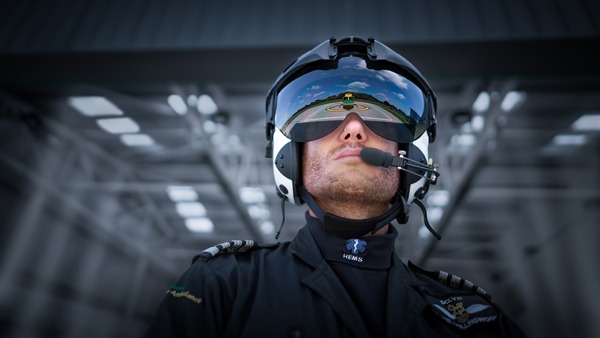Q&A with Terry Donnelly on his Air Ambulance Exhibit

Terry Donnelly is a freelance photographer from Liverpool, who has worked with a wide range of journalistic clients, such as the BBC, ESPN and the Guardian. His work has been exhibited all over the world and has earned over 230 awards. His latest photography exhibition focuses on Wiltshire Air Ambulance and the amazing work they do every day as a team. We asked him some questions about this exhibit, as well as the reasoning behind choosing to print his images.
What made you want to showcase an exhibit for the air ambulance service?
I’ve been involved with the emergency services since 2003, and I’ve always wanted to dig deep into the paramedic and air ambulance service. I believe what they do is quite remarkable, and the fact that they’re only used for serious incidents shows how important they are to the country. Almost every mission they go out on is to save lives.
Terry Donnelly is a freelance photographer from Liverpool, who has worked with a wide range of journalistic clients, such as the BBC, ESPN and the Guardian. His work has been exhibited all over the world and has earned over 230 awards. His latest photography exhibition focuses on Wiltshire Air Ambulance and the amazing work they do every day as a team. We asked him some questions about this exhibit, as well as the reasoning behind choosing to print his images.
What made you want to showcase an exhibit for the air ambulance service?
I’ve been involved with the emergency services since 2003, and I’ve always wanted to dig deep into the paramedic and air ambulance service. I believe what they do is quite remarkable, and the fact that they’re only used for serious incidents shows how important they are to the country. Almost every mission they go out on is to save lives.
After a lot of research, I visited the Wiltshire base which was recommended to me by a friend who worked for the air ambulance service. The reason he recommended it to me was because it’s a single site that had both paramedics on the ground and pilots in the air. However, they work as a single unit, and that’s what I wanted to show with this exhibition. I wanted to tell the story of them and all the great things they do. 
Can you tell us a little about your experience and what goes on in the day-to-day at base?
I spent around 5 days at base in July and August, mostly shadowing the team on their downtime. The reason for this is because I couldn’t distract them. The reason the air ambulance can scramble in 2 minutes and can reach any part of Wiltshire within 7 minutes, is because the team needs to be alert and ready.
They don’t always take the helicopter, however. They know within seconds of being contacted whether taking a car or the helicopter would be quicker/more beneficial. There are also occasions where the helicopter isn’t allowed to take off due to poor weather and visibility. The team as a whole on average, responds to 3 lifesaving incidents a day, and both the cars and helicopter have matching equipment, making both huge assets to emergency healthcare.
Did you discover anything that shocked/surprised you?

There were a few things I didn’t expect, both professionally and personally. I got to know the people really well whilst I was there and discovered so much about their job and in some cases, what it took to get there.
The majority of the pilots are all ex-military pilots who after leaving the military, signed up to do this. When they explained it, it makes sense really, as these pilots are used to landing in tricky, under pressure situations that come with the job as an air ambulance pilot.
Another thing that shocked me is that all paramedic staff, whilst already highly trained and skilled, have to train in observation along with the pilots so they can assist them whilst flying to an incident. They can then aid the pilots on where the incident is and the best possible place to land.
The one-story that stuck with me, however, was one of huge dedication. I was speaking to a man from South Africa who came to the UK to work as a paramedic after doing the job and studying the qualifications years previous. He was told that his qualifications were not valid in the UK and so he couldn’t work.
He decided to go back to study in the UK so he could start working in the UK. I think it’s such a privilege that people from all around the world want to work for our emergency services, and this story is just one of thousands within the frontlines of the UK’s medical services.
What was the decision behind printing your photos?
The pictures do look impressive on a screen, however, there’s something about putting a photo to print that brings out more emotion and puts more life into the picture. I once showed a woman a picture I took on a screen, and then later showed her it in print. She cried when she saw the print version, but felt nothing when it came to the photo on screen. This shows why you should be printing your images, it gives the viewer a more emotional connection to the photo.
The pictures for the exhibition were kindly printed by the Fotospeed team. There were around 60 pictures, some A1 and some A3, printed on Smooth Pearl 290. It’s a very natural looking paper, that brings out colours really well due to its high colour gamut. It works perfectly for the exhibition photos as well, and really brings the feeling and dedication out of them.
You can see Terry’s exhibition at the following venue:
Witshire Air Ambulance Headquaters - Semington - From the end of March 2020 - date TBC
To check out more blogs, click here. To see more on Terry Donnelly, click here.



